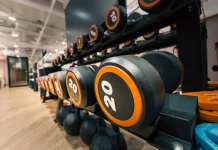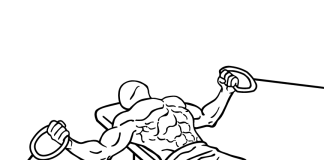Last Updated on September 26, 2014
The Iron Cross with Dumbbells is an advanced, dynamic exercise that challenges and strengthens the entire body. This movement combines balance, control, and strength, targeting multiple muscle groups, including the shoulders, chest, core, glutes, and legs. Whether you’re looking to build functional strength, enhance muscle endurance, or refine your athletic capabilities, this exercise is a fantastic addition to your fitness regimen.
In this in-depth guide, we’ll break down everything you need to know about the Iron Cross with Dumbbells, including how to perform it correctly, the benefits, variations, and common mistakes to avoid.
What is the Iron Cross with Dumbbells?
The Iron Cross exercise is inspired by gymnastics and adapted for weight training using dumbbells. Traditionally, it’s a move that gymnasts perform on rings, but the weighted version allows you to build similar strength benefits while working on stability and control. This full-body movement activates the legs, shoulders, chest, core, and even the back, making it a comprehensive workout in a single exercise.
Muscles Worked
The Iron Cross with Dumbbells primarily targets:
- Deltoids: The front, side, and rear delts are activated as you move your arms to the side and hold them in a static position.
- Chest (Pectorals): The movement also engages the chest muscles as you control the dumbbells and open your arms.
- Core: Maintaining balance during the movement activates the core, especially the obliques and lower abs, as you hold a squat stance.
- Legs (Quads and Glutes): The squat position engages the quadriceps and glutes, making it a lower-body workout as well.
- Trapezius and Upper Back: Holding the dumbbells at shoulder height and maintaining control also engages the upper back muscles.
How to Perform the Iron Cross with Dumbbells: Step-by-Step Guide
The Iron Cross is a compound movement that requires proper form and technique. Here’s how to execute it:
- Starting Position:
- Stand with your feet shoulder-width apart, holding a light dumbbell in each hand.
- Lower into a squat stance (about half squat depth), ensuring your back remains straight and your core engaged.
- Extend your arms in front of you, palms facing each other, holding the dumbbells at shoulder height.
- The Movement:
- Slowly stand upright while moving your arms out to your sides, forming a “T” shape or cross.
- Keep your arms straight and your elbows slightly bent to avoid hyperextension.
- Ensure your palms are facing forward at the end of the movement.
- Return to the Starting Position:
- Bring your arms back in front of you, maintaining control of the dumbbells.
- Lower back into the squat stance, engaging your core and legs to stabilize your body.
- Repetitions:
- Perform the movement for 10-15 repetitions, maintaining control and focusing on smooth transitions between positions.
Tips for Proper Form
To maximize the benefits and ensure safety, keep these tips in mind:
- Start with Light Weights: Begin with light dumbbells (3-5 pounds) to familiarize yourself with the movement and prevent strain or injury.
- Engage Your Core: Keep your core tight throughout the exercise to stabilize your body and prevent your lower back from arching.
- Maintain Proper Posture: Keep your chest lifted, shoulders back, and spine neutral as you transition between movements.
- Control the Motion: Avoid swinging the weights. Instead, move in a controlled manner to maintain muscle engagement and form integrity.
Benefits of the Iron Cross with Dumbbells
- Full-Body Activation: This exercise engages multiple muscle groups, making it an efficient way to work on both upper and lower body strength simultaneously.
- Improves Shoulder Mobility: The wide arm movement stretches and strengthens the shoulder muscles, improving flexibility and range of motion.
- Core Stabilization: Holding a squat stance and balancing the weight in your arms activates the core, enhancing balance and stability.
- Enhances Functional Strength: The combination of upper body strength and lower body stability makes the Iron Cross with Dumbbells a functional exercise that improves your athletic performance and daily movement patterns.
- Builds Endurance: Holding and moving the weights through a wide range of motion challenges muscle endurance, making it an excellent conditioning exercise.
Variations of the Iron Cross with Dumbbells
To add variety and progressively challenge your muscles, consider incorporating these variations:
1. Standing Iron Cross
Instead of starting in a squat, perform the exercise from a standing position. This variation focuses on upper body strength and control.
- How to Perform: Stand upright with feet shoulder-width apart, holding a dumbbell in each hand. Extend your arms out to the sides, forming a “T” shape. Return your arms to the front and repeat.
2. Iron Cross with Squat Hold
This variation combines the Iron Cross with an isometric squat hold, increasing the difficulty by engaging the lower body muscles for a longer duration.
- How to Perform: Lower into a squat position with your arms extended in front. Perform the arm movement while maintaining the squat hold throughout the entire set. This variation works the quads and glutes intensively while engaging the upper body.
3. Alternating Iron Cross
Instead of moving both arms simultaneously, alternate between your left and right arm, adding a coordination element to the exercise.
- How to Perform: Stand with feet shoulder-width apart. Hold the squat stance and extend one arm to the side while keeping the other in front. Alternate arms with each repetition. This variation enhances shoulder isolation and core stabilization.
4. Iron Cross with Lunge Stance
For a more advanced challenge, perform the Iron Cross in a lunge position, engaging your lower body muscles differently.
- How to Perform: Assume a lunge position with one foot forward and the other extended behind you. Perform the arm movements while holding the lunge stance. This variation engages the glutes, quads, and core more intensively.
Common Mistakes to Avoid
Despite the simplicity of the movement, there are common errors that can affect the effectiveness of the exercise or lead to injury:
- Using Heavy Weights Too Soon: The Iron Cross is an advanced movement that requires stability and control. Avoid heavy weights until you’ve mastered the technique with lighter dumbbells.
- Overextending the Arms: Hyperextending the arms when forming the “T” shape can strain the shoulder joints. Keep a slight bend in the elbows to protect your joints.
- Arching the Back: When standing upright or in a squat stance, engaging the core is crucial to avoid arching the lower back, which can lead to discomfort or injury.
- Rushing the Movement: Performing the exercise too quickly reduces its effectiveness and increases the risk of injury. Maintain a controlled pace for optimal muscle engagement.
Programming the Iron Cross into Your Workout
Integrating the Iron Cross into your fitness routine can be beneficial for building strength, improving mobility, and enhancing muscle endurance. Here’s how you can include it:
- Warm-Up Activation: Include the Iron Cross with light dumbbells during your warm-up routine to activate your shoulders and core.
- Strength and Conditioning Workouts: Add the Iron Cross as part of a circuit with other compound movements for a full-body workout.
- Rehabilitation Programs: For those recovering from shoulder injuries, this exercise can help build strength and improve mobility when performed with light weights and proper form.
FAQs About the Iron Cross with Dumbbells
Q1: How heavy should the dumbbells be for the Iron Cross?
Start with light weights, such as 3-5 pounds, to ensure that you can maintain proper form and control. Once you feel comfortable, you can gradually increase the weight based on your strength and stability.
Q2: Is the Iron Cross suitable for beginners?
The Iron Cross is more suited for individuals with some experience in weight training due to its complexity and the coordination required. Beginners should start with basic shoulder exercises before progressing to the Iron Cross.
Q3: Can I perform the Iron Cross with resistance bands instead?
Yes, resistance bands are a suitable alternative if you do not have access to dumbbells. Ensure the bands provide light resistance to start, and follow the same movement pattern to engage the muscles effectively.
Q4: How often should I do the Iron Cross?
For strength and endurance, perform the Iron Cross 2-3 times per week, allowing sufficient rest between sessions to avoid overworking the shoulders.
Conclusion
The Iron Cross with Dumbbells is an effective, full-body exercise that challenges strength, stability, and muscle endurance. By following proper technique, avoiding common mistakes, and integrating variations, you can maximize the benefits of this advanced movement. Whether you’re an athlete aiming to enhance performance, a fitness enthusiast building functional strength, or someone seeking a challenging new exercise, the Iron Cross is a powerful addition to your workout routine.






